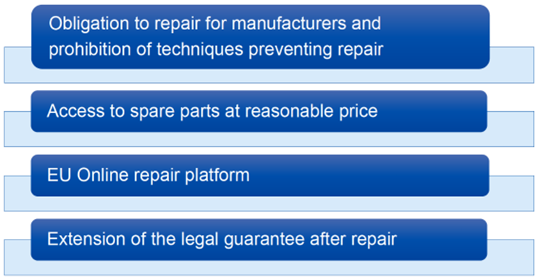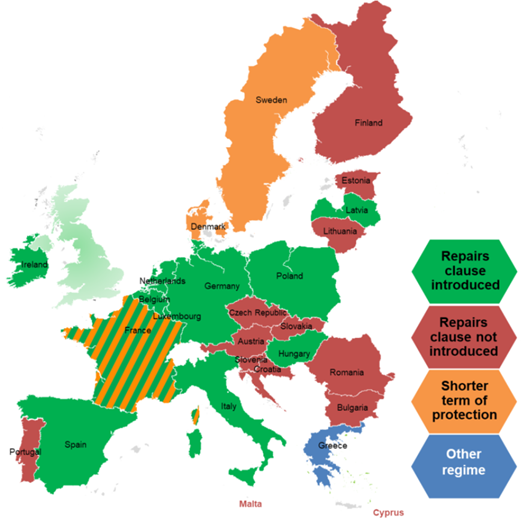1. Introduction
The transition to a circular economy has become a central pillar of the European Union’s sustainability agenda. A critical component of this transition is the Directive on common rules promoting the repair of goods, also called the Right to Repair Directive, which was adopted on 13 June 2024 and which entered into force on 30 July 2024. The Directive aims to extend product lifespans, reduce electronic waste, and empower consumers with access to repair services. This Directive aligns with the EU’s broader commitments to decarbonization and industrial resilience, particularly within the framework of the Clean Industrial Deal, published on 26 February 2025.
As Ursula von der Leyen, President of the European Commission, stated in her Political Guidelines for the European Commission 2024 to 2029: “We must and will stay the course on the goals set out in the European Green Deal. The climate crisis is accelerating at pace. And there is an equally urgent need to decarbonise and industrialise our economy at the same time.” (European Commission, 2024). This statement reinforces the EU’s dedication to sustainability and economic transformation and underlines the role of regulatory measures like the Right to Repair Directive in achieving these objectives.
Further underscoring Team Europe’s commitment, the new European Commission now includes an Executive Vice President for Clean, Just and Competitive Transformation, a Commissioner for Climate Action, Net Zero and Green Growth, and a Commissioner for Environment, Water Resilience and a Competitive Circular Economy. These roles highlight the Commission’s integrated approach to tackling climate challenges while ensuring industrial competitiveness and social equity. Notably, these institutional changes provide the necessary governance to oversee the implementation and enforcement of the Right to Repair Directive across Europe.
Working to decarbonise our economies will be part of our continued shift to a more sustainable pattern of production and consumption, retaining the value of resources in our economy for longer. For this purpose, the European Commission aims to present a new Circular Economy Act in 2026, which will help to create market demand for secondary materials and a single market for waste, notably in relation to critical raw materials.
The Clean Industrial Deal, alongside initiatives such as the Global Gateway Investment Package, underscores the importance of international collaboration in achieving a sustainable and resource-efficient economy. However, at its core, the Right to Repair Directive remains an essential consumer-focused policy, ensuring that European citizens have affordable and practical repair options. By integrating the Right to Repair within these larger policy frameworks, the EU seeks to reinforce its global leadership in circular economy practices while fostering international partnerships for sustainable development.
2. Overview of the Right to Repair Directive
Re-using, recycling and repairing are all integral parts of a circular economy, which entails the following three principles: 1) Design out Waster, 2) Keep Products in Use, and 3) Recover Natural Capital.

Main Elements
The Directive aims at encouraging consumers to use their goods for longer thus preventing premature disposal of repairable goods. It establishes a number of measures to promote repair:
- Obligation to repair: Manufacturers of products (e.g., fridges or smartphones) that are subject to reparability requirements in EU law and listed in Annex II of the Directive will have to repair those products within a reasonable time and for a reasonable price.
- European Online Platform for repair: Consumers will be able to find repairers more easily through a new online European Repair Platform, which will be established as an extension of “Your Europe” portal.
- Extension of the legal guarantee after repair: Provides consumers with an extra year of the legal guarantee if they choose to repair the product instead of replacing it under the legal guarantee.
- National measures promoting repair: Member States will have to take at least one measure promoting repair on their territory. This can include both financial and non-financial measures such as information campaigns, repair vouchers, trainings in repair skills.
- European Repair Information Form: Repairers will be able to offer to consumers information about their repair services via a standardised European Repair Information Form, allowing them to compare different repair offers more easily.

Key Provisions
The Right to Repair Directive establishes clear obligations for manufacturers and rights for consumers, including:
- Manufacturer Responsibilities: Ensuring spare parts and repair information are available for a minimum period beyond a product’s warranty.
- Consumer Rights: Greater transparency regarding repair options, including standardized labeling on product reparability.
- Scope & Limitations: Initially covering household appliances, electronics, and ICT products, with potential future expansion to other sectors.
This directive is expected to reduce premature product obsolescence, encourage manufacturers to design more repair-friendly products, and foster a stronger repair economy within Europe.


Alignment with the Clean Industrial Deal
The Clean Industrial Deal emphasizes the importance of circular economy principles in reducing industrial emissions and resource depletion. By fostering the reparability of products, the Directive contributes to waste reduction, energy efficiency, and sustainable industrial practices, key objectives under this deal. Furthermore, the directive complements existing EU legislation, such as the Ecodesign for Sustainable Products Regulation, by requiring manufacturers to consider reparability at the design stage (European Commission, 2023).
3. International Partnerships and the Global Gateway Investment Package
Global Gateway Overview
The EU’s Global Gateway initiative is a €300 billion investment strategy aimed at supporting infrastructure, connectivity, and sustainability projects worldwide. This initiative promotes resilient supply chains and aligns with global sustainability goals, making it a crucial enabler for expanding the Right to Repair beyond Europe.
Synergies with the Right to Repair Directive
International partnerships facilitated by the Global Gateway can:
- Improve the availability of spare parts by creating global supply networks for repairable components.
- Promote standardization of repair-friendly designs across different markets.
- Facilitate knowledge exchange on repair technologies and circular economy strategies.
Case Study – EU-Africa Collaboration
The EU-Africa Global Gateway Investment Package focuses on sustainable investments, including initiatives supporting e-waste management and repair industries. By encouraging repair industries in Africa, the initiative enhances job creation and reduces environmental degradation associated with electronic waste. Notably, this partnership can support the implementation of Right to Repair policies beyond Europe by strengthening international regulatory cooperation.
4. Funding Mechanisms and Implementation Strategies
Mobilizing Funds through the Global Gateway
The Global Gateway Investment Package can finance repair-focused projects, including:
- Establishing repair centers in key global markets.
- Developing training programs to build a skilled workforce in sustainable product maintenance.
- Invest in your start-up companies and SMEs through matching grant funds, as well as financial instruments that entail loan and guarantee facilities.
Role of the Industrial Decarbonization Bank
The Industrial Decarbonization Bank, a proposed €100 billion fund, supports clean technology investments. It could serve as a financial backbone for manufacturers adapting their designs to align with Right to Repair requirements. Providing financial incentives for companies to improve product reparability will be essential in ensuring widespread adoption of the directive’s principles.
Public-Private Partnerships
Collaboration between governments, private sectors, and NGOs can accelerate the adoption of repair-friendly policies. Incentives for manufacturers, investment in research, and consumer awareness campaigns will be critical in ensuring the directive’s success. This multi-stakeholder approach will also enhance enforcement mechanisms, ensuring that the directive does not remain a symbolic gesture but a practical and impactful policy.
5. Challenges and Future Outlook
Implementation Barriers
Despite its promise, the Right to Repair faces several challenges:
- European Law versus National Legislation: While most EU member states already translated the Right to Repair Directive into national law, especially Eastern European and Scandinavian countries are still lagging behind in its implementation.
- Manufacturer Resistance: Some industries argue that reparability requirements increase production costs, suggesting the cutting of red tapes.
- Technological Barriers: Issues such as software locks and proprietary components restrict independent repair services.
- Global Coordination: Ensuring international compatibility with the Directive remains a challenge, particularly in harmonizing standards with global trade partners.

Future Prospects
The EU remains strongly committed to building greener and fairer societies and economies in the EU and worldwide. The Right to Repair Directive, in tandem with the Clean Industrial Deal and Global Gateway Investment Package, paves the way for a more sustainable global economy. As the EU refines its policies, potential expansions could include:
- Right to Modify legislation, allowing consumers to adapt and customize their products.
- Software Repair Rights, ensuring long-term digital sustainability.
- Broader Sector Coverage, extending Right to Repair requirements to industries such as automotive and medical devices.
The Clean Industrial Deal will help the EU deliver our economic, social, environmental and security goals in a true spirit of cooperation and dialogue with our partners worldwide. The cutting of red tapes and simplifications that are under discussion will ensure that we can achieve those goals more effectively, while avoiding undue burdens on the companies that need to follow EU rules. This will make space for more innovation, more investments and more trade with our partners Proposals towards simplification will also help to ensure that responsible European companies can continue to invest in driving forward the changes that our partners want to see across the world, helping to achieve a fair digital and green transition
Conclusion
The Right to Repair Directive represents a transformative shift towards sustainability, aligning with broader EU initiatives such as the Clean Industrial Deal and Global Gateway Investment Package. By reinforcing consumer rights and compelling manufacturers to enhance product reparability, the directive serves as a cornerstone of the EU’s circular economy strategy. Furthermore, leveraging international partnerships and funding mechanisms will enhance its impact, setting a global precedent for circular economy policies. Moving forward, strong implementation strategies, transparent enforcement, and multi-stakeholder collaboration will be key to ensuring a successful transition towards a repair-friendly economy.
References
- European Commission (2024): Directive on common rules promoting the repair of goods https://commission.europa.eu/law/law-topic/consumer-protection-law/directive-repair-goods_en
- European Commission. (2023). Ecodesign for Sustainable Products Regulation https://commission.europa.eu/energy-climate-change-environment/standards-tools-and-labels/products-labelling-rules-and-requirements/ecodesign-sustainable-products-regulation_en
- European Commission. (2024). Political Guidelines for the European Commission 2024 to 2029 https://commission.europa.eu/document/download/e6cd4328-673c-4e7a-8683-f63ffb2cf648_en?filename=Political%20Guidelines%202024-2029_EN.pdf
- European Commission. (2025). Clean Industrial Deal https://commission.europa.eu/topics/eu-competitiveness/clean-industrial-deal_en
- European Commission. (2025). Global Gateway Investment Package https://international-partnerships.ec.europa.eu/policies/global-gateway/initiatives-sub-saharan-africa/eu-africa-global-gateway-investment-package_en

First Counsellor - Policy Advisor for Agriculture, Environment, Digital Transformation
Delegation of the European Union to the African Union (AU)
